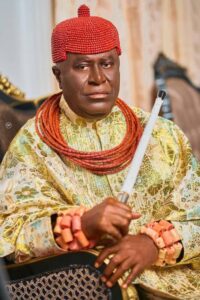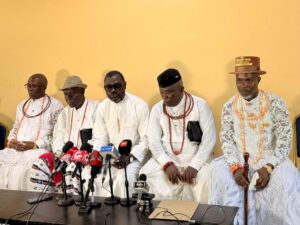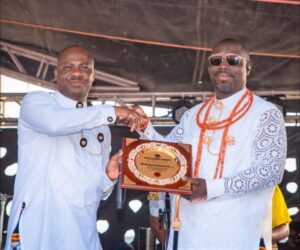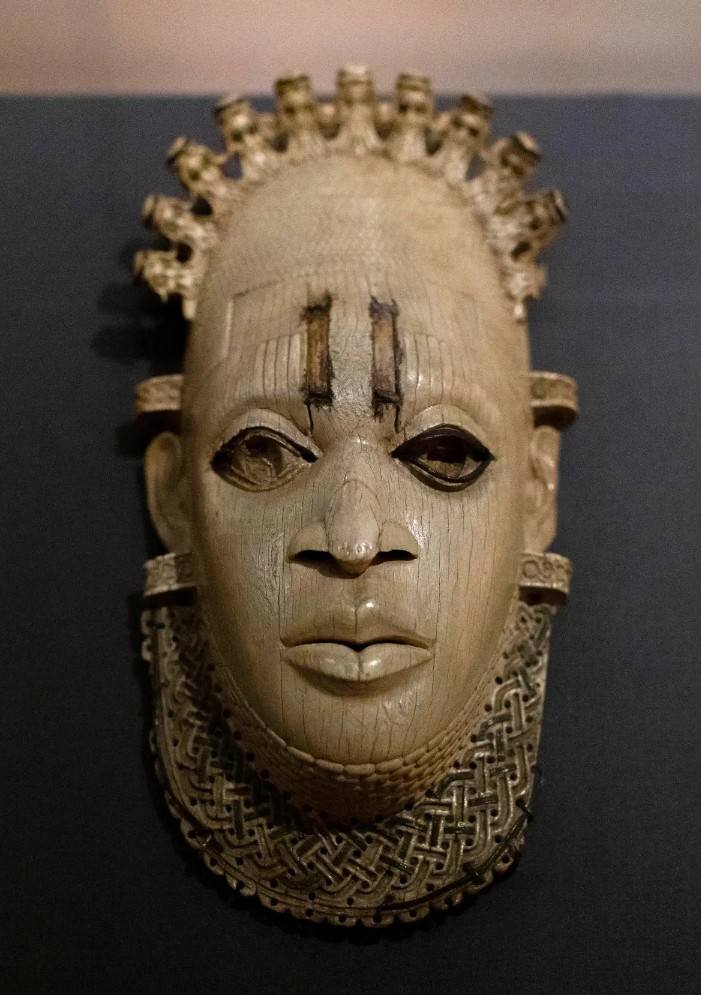
Mask of Queen Idia
By Kingsley Abavo, Benin
* How it all started, a special report by New York Times
Nigerian President, Muhammadu Buhari has again been appreciated for his efforts and the directives stating that the looted Benin Artefacts returned; should be taken to the Palace of the Monarch, HRM Oba Ewuare II.
Also, Governor Godwin Obaseki, and the Nigerian ambassador to Britain, Sarafa Tunji Isola on efforts made on the returned artefacts.
The commendation came from the priest of Holy Aruosa Cathedral, (Benin native Church); Ohen-Osa Igbinoghodua Edebiri during the 2021 Ugie thanksgiving service by the Benin Monarch, HRM Oba Ewuare II, last Sunday, 2 January, 2022.
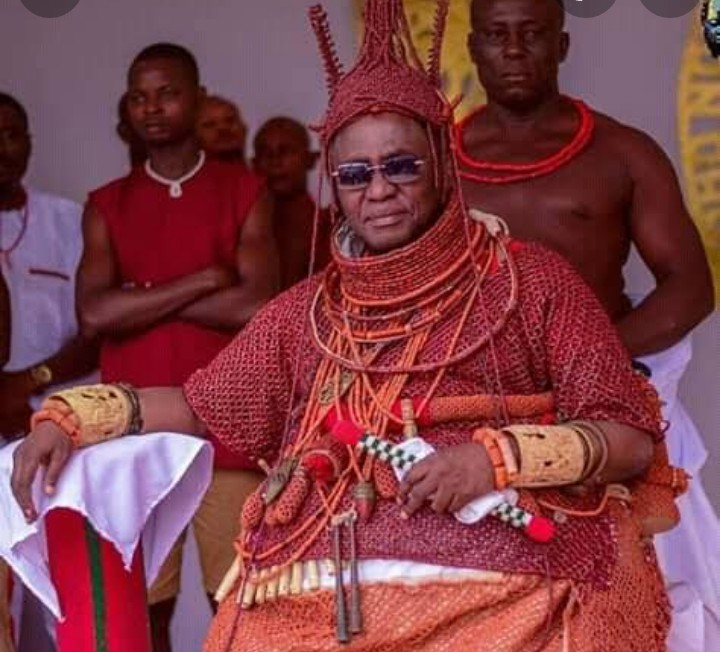
Delivering his sermon, he urged the congregation to be obedient to constituted authorities like the Oba which he explained, attracts great blessings from God Almighty stressing that the Benin Monarch, HRM Oba Ewuare II and other constituted authorities are God’s Representatives here on earth.
“Hence, everyone should be satisfied with them both in service and obedience”, he urged adding that there was need for everyone to serve God and humanity in truth to attract earthly and heavenly coverage of God.
Continuing, Ohen-Osa Edebiri said the Monarch has every reason to thank God for all he has done in year 2021.
Apart from the peaceful conclusion of the annual Ugie festival, there were other numerous blessings which includes: the birth of the quatruplets, conferment of the title of Iye Oba N’ Edo; Omo N’ Ikueyemwen, the returned artefacts and general peace experienced in the State.
He also used the occasion to appreciate the Emir of Kano, Aminu Ado Bayero and other top government officials for their roles in the return of the stolen Artefacts.
The market women group, Chiefs, Enigies, youth group and others were also appreciated by the Ohen-Osa for standing by the Monarch throughout the year particularly, during the run up to the return of the Artefacts.
He urged them to continue to give the Monarch all the necessary support to pilot the affairs of the kingdom, and play the stabilizing role in the State and country in general.
Highlight of the event was the special thanksgiving by the Monarch accompanied by members of the royal family, Chiefs , Enigies and others.
How it all started
By New York Times
The Benin Bronzes, some of Africa’s greatest treasures, were looted in 1897. After a chance encounter, two men made it their mission to return them.
The artifacts were looted by British troops in the 19th century and are now scattered worldwide.
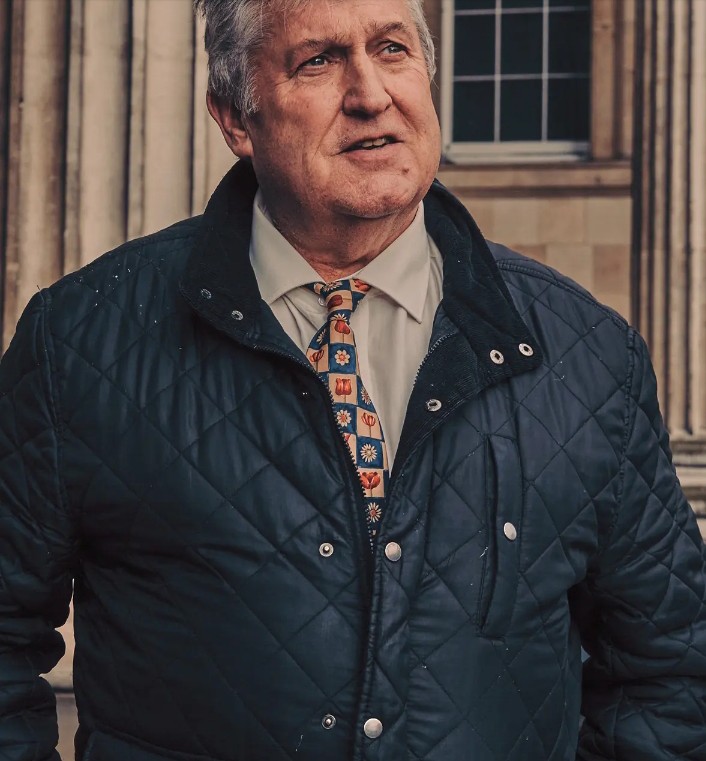
In 2004, Steve Dunstone and Timothy Awoyemi stood on a boat on the bank of the River Niger.
The two middle-aged men, both police officers in Britain, were taking part in a journey through Nigeria, organized through the Police Expedition Society, and had reached the small town of Agenebode, in the country’s south. Their group brought gifts with them from British schoolchildren, including books and supplies. The local schools had been alerted in advance, and a crowd came down to the river banks to meet them; there was even a dance performance.
It was a wonderful — if slightly overwhelming — welcome, Mr. Dunstone recalled.
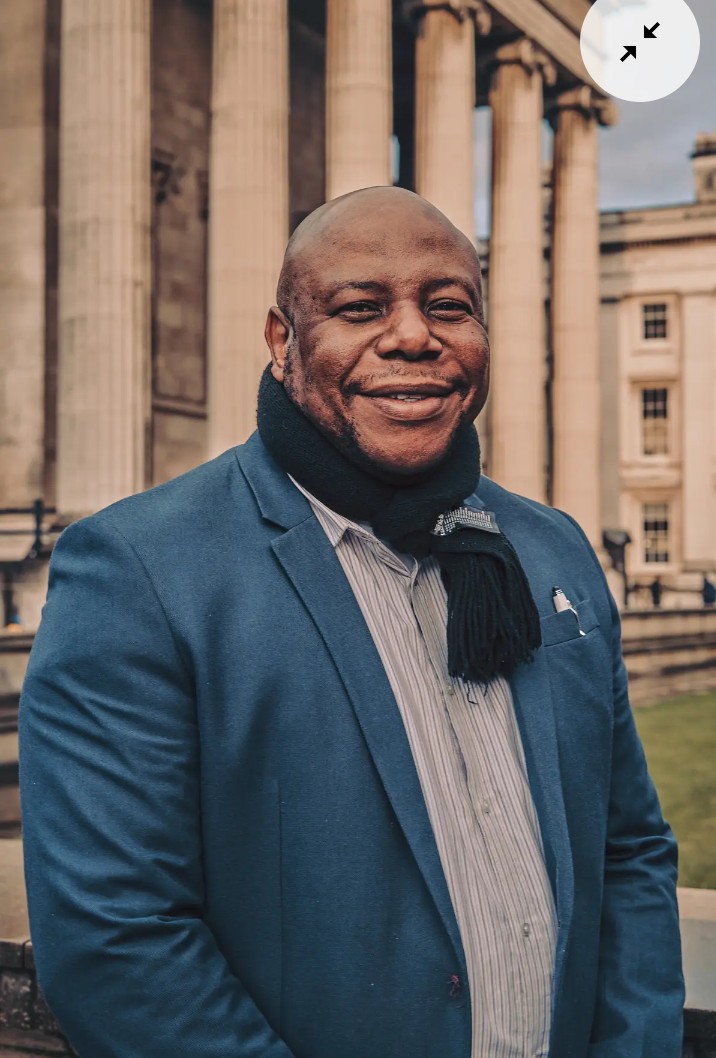
In the back of the crowd, Mr. Awoyemi, who was born in Britain and grew up in Nigeria, noticed two men holding what looked like political placards. They didn’t come forward, he said. But just as the boat was about to push off, one of the men suddenly clambered down toward it.
“He had a mustache, scruffy stubble, about 38 to 40, thin build,” Mr. Dunstone recalled recently. “He was wearing a white vest,” he added.
The man reached out his arm across the water and handed Mr. Dunstone a note, then hurried off with barely a word.
That night, Mr. Dunstone pulled the note from his pocket. Written on it were just six words: “Please help return the Benin Bronzes.”
At the time, he didn’t know what it meant. But that note was the beginning of a 10-year mission that would take Mr. Dunstone and Mr. Awoyemi from Nigeria to Britain and back again, involve the grandson of one of the British soldiers responsible for the looting, and see the pair embroiled in a debate about how to right the wrongs of the colonial past that has drawn in politicians, diplomats, historians and even a royal family.
By the end, Mr. Dunstone and Mr. Awoyemi would have done more to return looted art to Nigeria — with two small artifacts — than some of the world’s leading museums, where the debate over the right of return continues.
World Treasures
The Benin Bronzes are not actually from the country of Benin; they come from the ancient Kingdom of Benin, now in southern Nigeria.
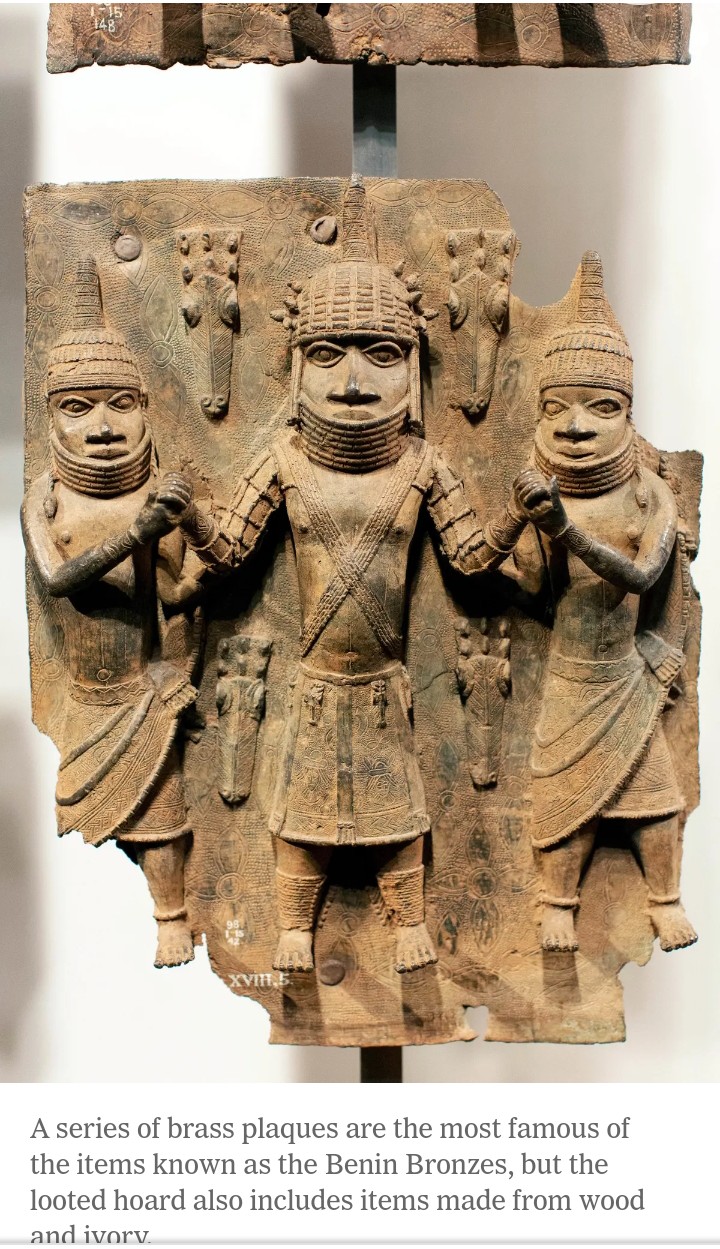
They’re also not made from bronze. The various artifacts we call the Benin Bronzes include carved elephant tusks and ivory leopard statues, even wooden heads. The most famous items are 900 brass plaques, dating mainly from the 16th and 17th centuries, once nailed to pillars in Benin’s royal palace.
There are at least 3,000 items scattered worldwide, maybe thousands more. No one’s entirely sure.
A series of brass plaques are the most famous of the items known as the Benin Bronzes, but the looted hoard also includes items made from wood and ivory.
You can find Benin Bronzes in many of the West’s great museums, including the British Museum in London and the Metropolitan Museum of Art in New York. They’re in smaller museums, too. The Lehman, Rockefeller, Ford and de Rothschild families have owned some. So did Pablo Picasso.
Their importance was appreciated in Europe from the moment they were first seen there in 1890s. Curators at the British Museum compared them at that time with the best of Italian and Greek sculpture.
Today, the artifacts still leave people dumbstruck. Neil MacGregor, the British Museum’s former director, has called them “great works of art” and “triumphs of metal casting.”
There’s one place, however, where few of the original artifacts are found: Benin City, where they were made.
That may change. Benin’s royal family and the Nigerian local and national governments plan to open a museum in Benin City in 2023 with at least 300 Benin Bronzes. Currently the site is a bit of land that’s little more than a traffic island.
Those pieces will come mainly from the collections of 10 major European museums, such as the Humboldt Forum in Berlin, the Weltmuseum in Vienna and the British Museum. They will initially be on loan for three years, with the possibility to renew. Or, when those loans run out, other Benin Bronzes could replace them. The museum could become a rotating display of the kingdom’s art.
This hugely complex initiative — organized through the Benin Dialogue Group, which first convened in 2010 — is being celebrated as a chance for people in Nigeria to see part of their cultural heritage. “I want people to be able to understand their past and see who we were,” said Godwin Obaseki, governor of Edo State, home to Benin City, and a key figure in the project.
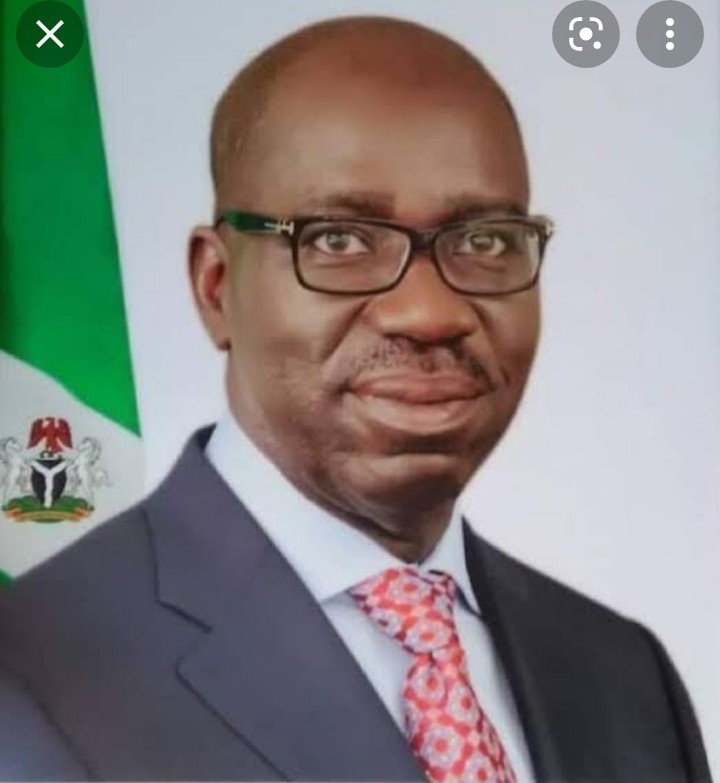
But is the Benin plan — a new museum filled with loans — a more practical solution than a full-scale return, long called for by many Nigerians and by some activists? That probably depends on what you think about how the Benin Bronzes were obtained in the first place.
Ill-Gotten Gains
On Jan. 2, 1897, James Phillips, a British official, set out from the coast of Nigeria to visit the oba, or ruler, of the Kingdom of Benin.
News reports said he took a handful of colleagues with him, and it’s assumed he went to persuade the oba to stop interrupting British trade. (He had written to colonial administrators, asking for permission to overthrow the oba, but was turned down.)
When Phillips was told the oba couldn’t see him because a religious festival was taking place, he went anyway.
He didn’t come back.
For the Benin Kingdom, the killing of Phillips and most of his party had huge repercussions. Within a month, Britain sent 1,200 soldiers to take revenge.
On Feb. 18, the British Army took Benin City in a violent raid. The news reports — including in The New York Times — were full of colonial jubilation. None of the reports mentioned that the British forces also used the opportunity to loot the city of its artifacts.
Among the items looted according to Capt Hebert Sutherland were: carved tusks, rows of artefacts which prior to being stolen, were used in altar displays to represent departed people like obas or queen mothers.
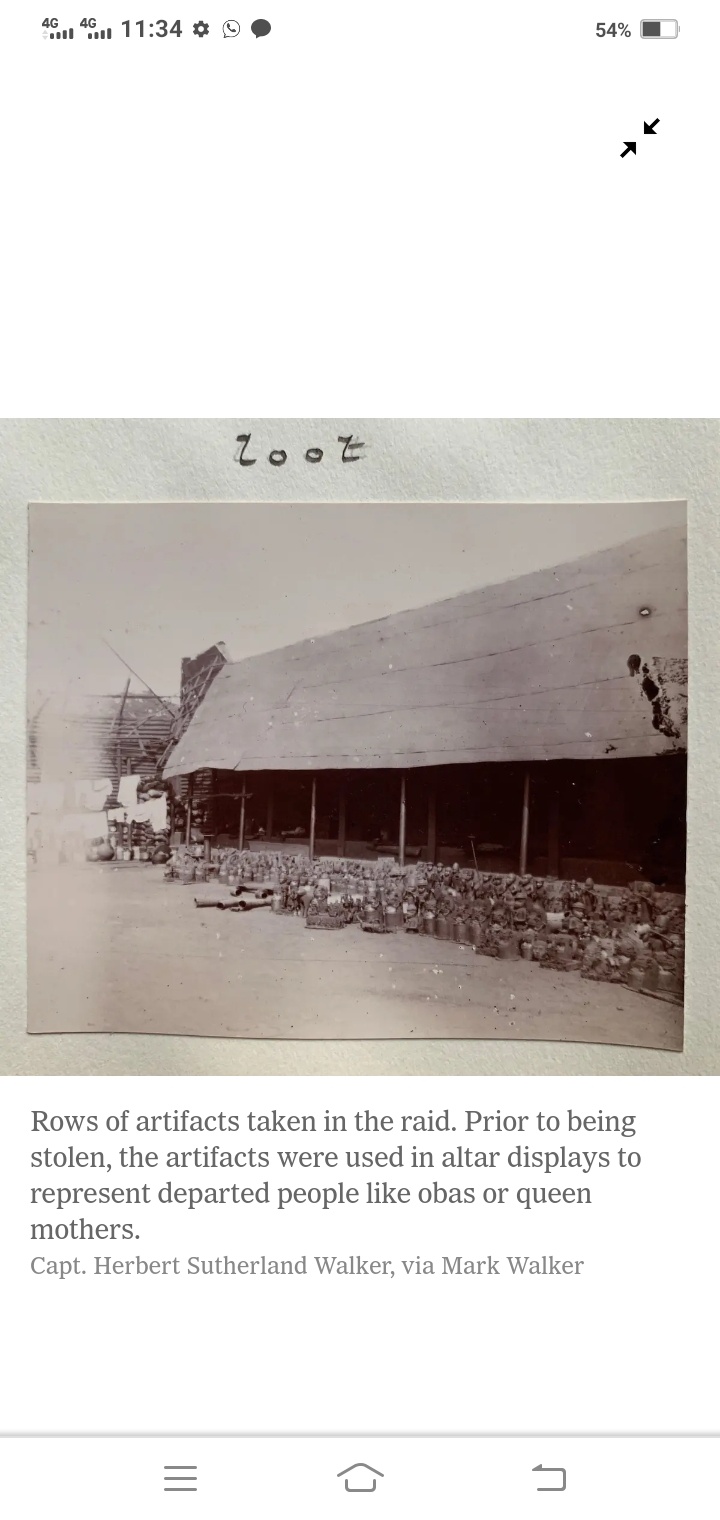
At least one British soldier was “wandering round with a chisel & hammer, knocking off brass figures & collecting all sorts of rubbish as loot,” Capt. Herbert Sutherland Walker, a British officer, wrote in his diary.
“All the stuff of any value found in the King’s palace, & surrounding houses, has been collected,” he added.
Piles of ceremonial tusks were taken by the British in Benin City in 1897, according to Captain Walker, who wrote the caption “more loot” .
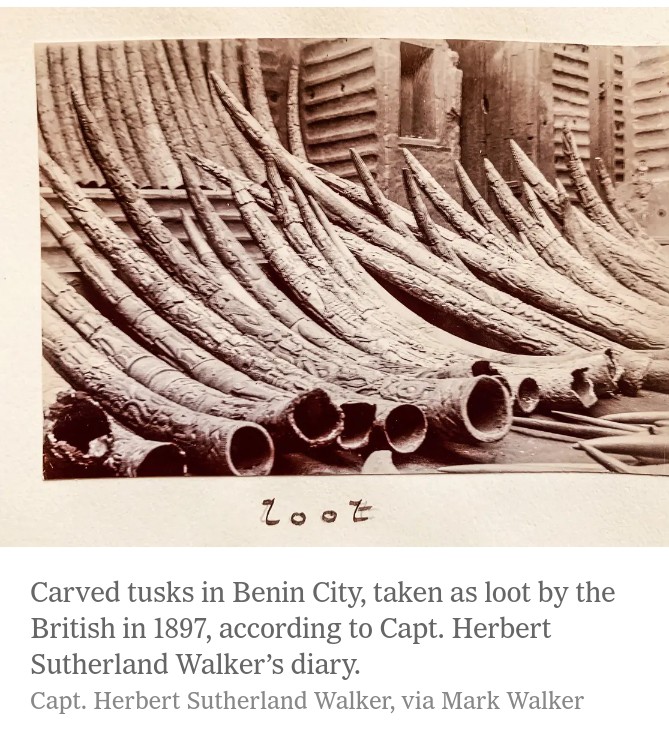 Within months, much of the bounty was in England. The artifacts were given to museums, or sold at auction, or kept by soldiers for their mantelpieces. Four items — including two ivory leopards — were given to Queen Victoria. Soon, many artifacts ended up elsewhere in Europe, and in the United States, too.
Within months, much of the bounty was in England. The artifacts were given to museums, or sold at auction, or kept by soldiers for their mantelpieces. Four items — including two ivory leopards — were given to Queen Victoria. Soon, many artifacts ended up elsewhere in Europe, and in the United States, too.
“We were once a mighty empire,” said Charles Omorodion, 62, an accountant who grew up in Benin City but now lives in Britain and has worked to get the pieces returned from British museums. “There were stories told about who we were, and these objects showed our strength, our identity,” he said.
He said that seeing the Benin Bronzes in the world’s museums filled him with pride, as they showed visitors how great the Benin Kingdom had been. But, he added, he also felt frustration, bitterness and anger about their being kept outside his country. “It’s not just they were stolen,” he said, “it’s that you can see them being displayed and sold at a price.”
Insult to Injury
Benin City has been calling for the return of its artifacts for decades. But a key moment came in the 1970s when the organizers of a major festival of black art and culture in Lagos, Nigeria, asked the British Museum for one prized item: a 16th-century ivory mask of a famous oba’s mother.
They wanted to borrow the work, to serve as the centerpiece of the 1977 event, but the British Museum said it was too fragile to travel. Nigeria’s news media told a different story, reporting that the British government had asked for $3 million insurance, a cost so high it was seen as a slap in the face.
That incident is still fresh in some Nigerians’ minds, more than 40 years later. At a recent meeting of the Benin Union of the United Kingdom, an expatriate group that meets at a church in south London, several members brought up versions of the festival incident when asked about the Benin Bronzes. Then they started criticizing British museums, which they said never seemed willing to return stolen items, despite repeated requests.
“I wouldn’t go there,” said Julie Omoregie, 61, when asked if she’d ever been to the British Museum, a half-hour away by subway, to see the mask. It was “an insult” that it was in the museum, she said. When she was a child, she recalled, her father would sing her a song about the raid, and she would cry every time. “It is time for them to give us back what they took from us,” she said.
David Omoregie, 64, another member of the group, said “The British are very good at telling you, ‘We are looking after it. If you’d been looking after it, it would have been stolen by now.’”
He agreed with that once, he said, but he didn’t anymore: “You can leave your car to rot outside your drive; at least it’s your car,” he added.
Some pieces stolen in the raid have gone back to Nigeria from institutions. In the 1950s, the British Museum sold several plaques to Nigeria for a planned museum in Lagos, for instance, and sold others on the open market. But those were not the free, full-scale returns.
Heading Back
When Mr. Dunstone got back to England from Nigeria, he couldn’t shake that note from his mind: “Please help return the Benin Bronzes.”
He didn’t even know what they were, he recalled recently, but Mr. Awoyemi did — he’d learned all about them and the 1897 raid as a teenager in Nigeria — and he filled Mr. Dunstone in.
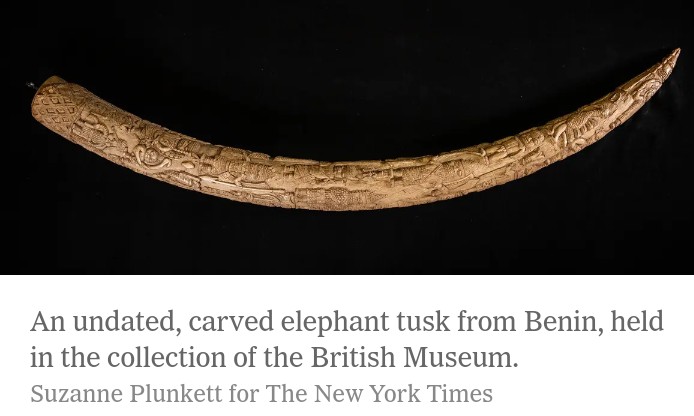
Mr. Dunstone simply couldn’t understand why Britain still had the Benin artifacts, he said. That feeling grew one day when he went to the British Museum to look at its collection. He was blown away by the 50-odd plaques on display, and more so when a security guard told him that there were 1,000 more items in the basement. (In fact, the museum owns around 900 items from Benin, and many are in storage in another building.)
“We really did steal them,” Mr. Dunstone, now 61, said. “We weren’t at war, we turned up and hacked them off the walls.”
In 2006, Mr. Dunstone created a web page about the Benin Bronzes, with Mr. Awoyemi’s input. He added a note at the bottom of the page asking anyone with information about the whereabouts of any items to get in touch. The two men, who became friends as colleagues in the police force protecting the British royal family, even wrote to the oba in Benin and the Nigerian government, asking for permission to act as envoys to Britain’s museums to try and get the artifacts back to Nigeria.
No one replied, Mr. Awoyemi, 52, said. “We were so passionate,” he added, “but we were becoming frustrated with the whole thing.”
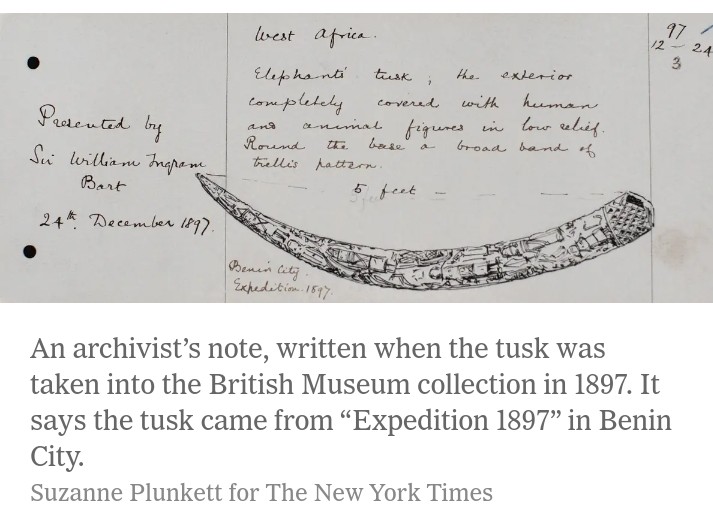
Mr. Awoyemi and Mr. Dunstone were just about to give up when, one day, in 2013, an email arrived. It was from a doctor from Wales named Mark Walker. Mr. Walker said he owned two of the looted items: a small bird that used to be on top of a staff, and a bell that had been struck to summon ancestors.
He wanted to give them back.
Mr. Walker, 72, is now retired and spends much of his time sailing. His grandfather was Captain Walker, who described the looting in his diary and took the pieces during the 1897 raid. They were once used as doorstops, Mr. Walker said, but after he inherited them they sat on a bookshelf, gathering dust. They’d be better off in Nigeria with the culture that created them, he said.
“My view is the British Museum should use modern technology to make perfect casts of its whole collection and send it all back,” he said recently. “You wouldn’t know the difference.”
At first, Mr. Walker didn’t want to go to Nigeria, afraid, Mr. Awoyemi said, that he might be prosecuted for having had them at all. But Mr. Awoyemi and Mr. Dunstone convinced him that the publicity from such a bold move could lead others to return items.
The Nigerian Embassy in London agreed to sponsor the trip, but pulled out when Mr. Walker insisted the items had to be returned directly to Benin City and the current oba, rather than to Nigeria’s president, Mr. Awoyemi said.
So Mr. Dunstone and Mr. Awoyemi mounted an amateur public relations campaign, securing appearances for themselves on radio and TV, to help raise the funds and show the royal court in Benin City that they were serious.
It worked.
In June 2014, Mr. Walker, Mr. Dunstone and Mr. Awoyemi headed to Benin City to return the artifacts to the oba.
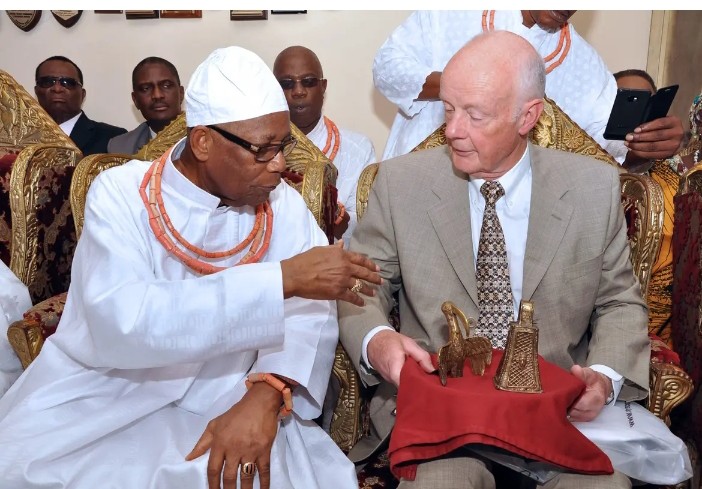
The ceremony at the oba’s palace was as overwhelming as the welcome on the river bank that had begun the whole journey, Mr. Dunstone said. It was filled with so many dignitaries and journalists, there was initially no room for him.
Mr. Walker said he handed over the objects quickly, without fuss. In return, the oba gave him, just as calmly, a tray of gifts, including a modern sculpture of a leopard head’s that weighed about 20 pounds.
“I was horrified,” Mr. Walker said. “I’d gone all that way to get rid of stuff, not get more.”
Where Next?
If there aren’t more individuals like Mr. Walker on the horizon, looking to give unwanted artifacts back, is the new museum full of items on loan the best Benin City can hope for?
Maybe.
Nigerian government officials have played down the need for items to be permanently returned. Mr. Obaseki, the state governor, said at a news conference at the British Museum last year: “These works are ambassadors. They represent who we are, and we feel we should take advantage of them to create a connection with the world.” His message: Nigeria wants them on display in the world’s museums, not just in Benin City.
Some museums do appear open to returning looted objects permanently, rather than lending them. Last March, the National Museum of World Cultures in the Netherlands launched a policy to consider claims for cultural objects acquired during colonial times.
Nigeria could claim the museum’s 170 or so artifacts from Benin City under the policy, if it proves that the items had been “involuntarily separated” from their rightful owners, or that the items are of such value to Nigeria that it “outweighs all benefits of retention by the national collection in the Netherlands.”
German museums have agreed to a similar policy.
Given how many Benin Bronzes are in Western museums, it seems likely some requests made under those policies would be accepted.
Until the museum in Benin City is built, however, nothing is likely to be returned permanently unless it is done by individuals. No one has a firm idea how many looted items are in private hands, but they used to regularly come up at auction. (The record price, set in 2016, is well over $4 million.)
Mr. Dunstone said he had hoped that dozens of people would have come forward with items to return by now. The ceremony in 2014 received a flurry of media attention, and he went back to England expecting new Mr. Walkers to appear.
It didn’t happen. He got one email from a man in South Africa who claimed to have fished a Benin Bronze out of a river. He was willing to mail it to Mr. Dunstone for $2,500.
Mr. Dunstone, ever the police officer, suspected a scam and didn’t write back.
“I’m less proactive now,” he said. “But my heart’s still open.”
Mr. Awoyemi said he was disappointed, too, that no one came forward, but was excited by the museum plan. He was even willing to help with security, he said, if the oba would let him.
Mr. Walker can’t put the Benin Bronzes behind him, either. A few months ago, he was looking online at Benin Bronzes held by the Horniman Museum in London and came across an intricately carved wooden paddle. It was almost identical to two he had in his home, which he thought his parents had bought on vacation.
Then he realized his grandfather must have looted them from Benin City, too.
In December, he lent the paddles to the Pitt Rivers Museum in Oxford — a member of the Benin Dialogue Group — with one condition: They had to be returned to Benin City within three years.
He wasn’t going to be getting on a plane with Mr. Dunstone and Mr. Awoyemi this time. “It would be harder to get two six-foot paddles through customs,” he said. He also didn’t want his motives questioned. He wasn’t returning the items for glory, he said: They should just go back. It’s the right thing to do.
Credit: New York Times

